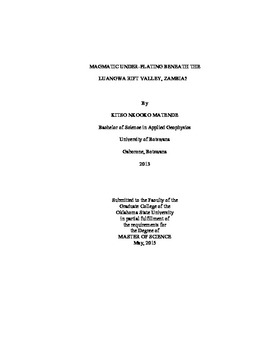| dc.contributor.advisor | Atekwana, Estella A. | |
| dc.contributor.author | Matende, Kitso Nkooko | |
| dc.date.accessioned | 2016-09-29T18:35:51Z | |
| dc.date.available | 2016-09-29T18:35:51Z | |
| dc.date.issued | 2015-05-01 | |
| dc.identifier.uri | https://hdl.handle.net/11244/45186 | |
| dc.description.abstract | We used aeromagnetic data, and satellite and terrestrial gravity data to examine the thermal and crustal structure beneath the Karoo-aged Luangwa Rift Valley (LRV) in Zambia in order to determine the geodynamic controls of its formation. We computed Curie Point Depth (CPD) values using two-dimensional (2D) power spectrum analysis of the aeromagnetic data, and these results were used to calculate heat flow under the LRV. We also inverted the aeromagnetic data for three-dimensional (3D) magnetic susceptibility distribution. We further determined the crustal thickness beneath the LRV by calculating depths to the Moho using 2D power spectrum analysis of the satellite gravity data. We found that: (1) there is no elevated CPD beneath the LRV, and as such no elevated heat flow anomaly. (2) there are numerous 5-15 km wide magnetic bodies at shallow depth (5-20 km) under the LRV. (3) the Moho beneath the LRV is 50 km deep, compared to 35-45 km depths outside the rift. The gravity-derived Moho depths beneath the LRV differ from Moho depths determined from preliminary results of passive seismic studies but are comparable with those outside the rift. (4) there is a broad long-wavelength positive anomaly in the terrestrial gravity data, possibly related to the presence of dense material at the Moho level. This anomaly is modified by shorter-wavelength positive anomalies at the rift shoulders and floor that might be related to shallow depth magnetic bodies. Also, there are negative short-wavelength anomalies that correlate with rift sediment infill. We subsequently used the ground gravity data to develop 2D forward models to reconcile the observed thermal and crustal characteristics of the LRV. Our models suggest that the deeper Moho beneath the rift is due to the presence of a magmatic under-plated mafic body. The difference between the gravity and passive seismic Moho depths estimates may be because the passive seismic data imaged the top of the under-plated mafic body whereas the gravity data imaged the base. Magmatic under-plating may have introduced a rheological weakness that facilitated strain localization during rift initiation. | |
| dc.format | application/pdf | |
| dc.language | en_US | |
| dc.rights | Copyright is held by the author who has granted the Oklahoma State University Library the non-exclusive right to share this material in its institutional repository. Contact Digital Library Services at lib-dls@okstate.edu or 405-744-9161 for the permission policy on the use, reproduction or distribution of this material. | |
| dc.title | Magmatic Under-plating Beneath the Luangwa Rift Valley, Zambia? | |
| dc.type | text | |
| dc.contributor.committeeMember | Abdelsalam, Mohamed G. | |
| dc.contributor.committeeMember | La�-D�vila, Daniel A. | |
| osu.filename | Matende_okstate_0664M_14020.pdf | |
| osu.accesstype | Open Access | |
| dc.description.department | Geology | |
| dc.type.genre | Thesis | |
